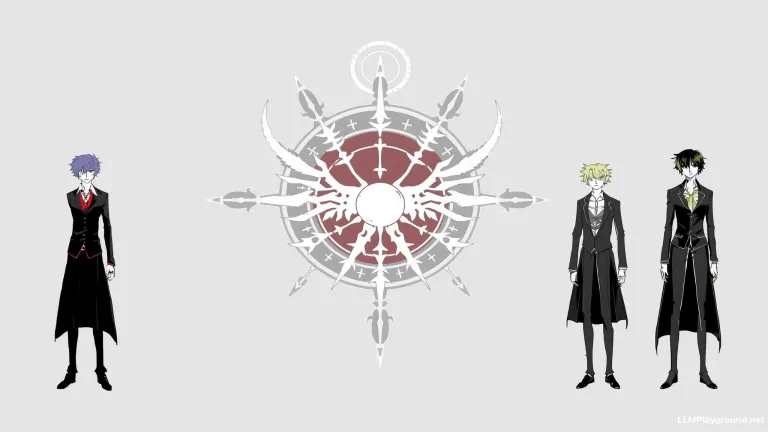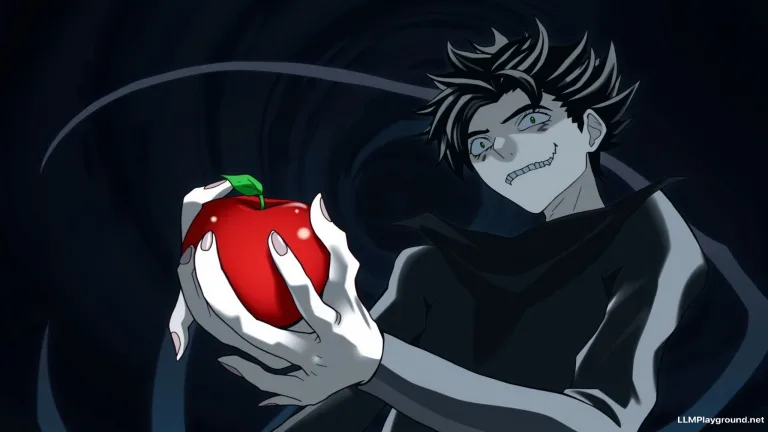
Introduction
In the captivating world of anime and manga, few series have ignited as much fascination and debate as 'Death Note.' Not only does this iconic series weave an intricate tale of morality, justice, and the battle between good and evil, but it also presents a rich tapestry of characters, each designed with profound symbolism. The tension-filled journey of Light Yagami, the enigmatic L, and the deadly Shinigami Ryuk is more than just a story of cat and mouse; it's a deep exploration of human nature, choices, and the consequences that follow. Every character, from the seemingly innocent to the overtly malevolent, embodies different facets of the human psyche and moral dilemmas. Their designs—colors, attire, and even posture—hold meanings that resonate with the viewer on multiple levels. In this blog post, we’ll delve into the symbolism behind these characters, uncovering not just who they are but what they represent within the broader narrative of 'Death Note.' We'll explore how their design choices illuminate their inner conflicts and motivations, offering a deeper understanding of this masterpiece. Join us as we unravel the layered meanings behind each character, showcasing why 'Death Note' remains a beloved and compelling series that invites viewers to reflect on righteousness and the very essence of life and death.
The Art of Darkness: Exploring Light Yagami
Light Yagami, the central character of 'Death Note', is a brilliant high school student whose descent into darkness serves as a profound exploration of morality and justice. His design reflects his dual nature: on the surface, he appears perfectly polished with sharp features and a meticulously styled appearance, embodying the ideals of a traditional hero. Yet, this polished exterior starkly contrasts with the disturbing depths of his ambition and desire for power. His well-groomed look signifies his intelligence and charisma, but as the series unfolds, the shadows beneath his persona become more prominent, illustrating the stark duality of man’s nature.
The symbolism of Light Yagami’s character design also extends to his color palette. He often dons neutral colors like blue and white, colors associated with cleanliness and order, which align with his initial goal of creating a utopia. However, as he becomes more consumed by the Death Note, darker colors begin to invade his attire, symbolizing his moral decay and the sinister path he chooses. The transformation in Light’s appearance over the series mirrors his internal struggle and the corruptive influence of absolute power. As viewers, we witness the metamorphosis of an idealistic young man into a ruthless antihero, showcasing the brilliant yet chilling artistry that defines his character.
The Enigmatic Shinigami: Ryuk's Design

Ryuk, the Shinigami who drops the Death Note into Light Yagami's world, is an imposing figure cloaked in an aura of mystery and intrigue. His design diverges from traditional depictions of death entities, embodying a blend of unsettling and whimsical characteristics. Ryuk's exaggerated features, such as his large, bat-like wings and unsettling grin, symbolize the darker aspects of human nature and the consequences of wielding the Death Note. His distinct portrayal stands as a reminder of the moral complexities surrounding the use of power, urging viewers to question what it means to take a life, even with the best intentions.
The palette of Ryuk's design reinforces his supernatural essence, employing dark hues interspersed with striking accents that capture the viewer's attention. This contrast not only heightens his otherworldly persona but also reflects the chaotic impact of the Death Note on both the user and the victims. Throughout the series, Ryuk serves as a spectator of human folly, showcasing how curiosity and ambition can lead individuals to make dangerous choices—an essential theme that resonates with audiences. Ultimately, Ryuk's design is more than just aesthetic; it encapsulates the series' exploration of morality, mortality, and the thin line between justice and vengeance.
The Duality of L: Genius and Quirkiness

L, one of the most iconic characters in Death Note, embodies a fascinating duality that captivates audiences. On the surface, he appears to be an eccentric genius with his disheveled hair, unconventional attire, and peculiar habits. His unique posture, often seen crouching or sitting in a strange manner, symbolizes his detachment from societal norms and foreshadows his role as a brilliant detective. This quirkiness serves a deeper purpose; it allows L to navigate the world differently, focusing on details that others may overlook. His choices highlight how genius often lives hand-in-hand with unusual behaviors, challenging the stereotype of the archetypal detective. Additionally, L's intelligence is portrayed through his analytical skills and deductive reasoning, indicating that brilliance often comes packaged in unexpected forms. He solves intricate puzzles and builds strategies against Kira, showcasing his mental acumen. Yet, this brilliance is counterbalanced by his social awkwardness and dependence on sweets, making him relatable and human. This balance between genius and quirkiness allows L to stand out in Death Note's intricate narrative, creating a character that echoes the complexities of real-life savants. As viewers, we are invited to appreciate not just the genius of L, but also the humanity that comes with it, exploring the beautiful chaos that defines his character.
Misa Amane: The Idol with a Hidden Agenda
Misa Amane, the iconic character from Death Note, embodies the complex interplay between beauty and darkness. As a popular idol, her bright personality and captivating appearance are designed to capture the viewer's attention. However, beneath this facade lies a fervent devotion to Kira, showcasing how her adoration can easily morph into obsession. Misa’s doll-like features, from her large expressive eyes to her gothic fashion sense, symbolize the clash between innocence and malevolence. This dualism is perfect for representing the contrast of public persona versus private motivations, a recurring theme in the series.
Furthermore, Misa’s character design reflects her role as a pawn in the larger game of cat and mouse between Kira and L. Her dramatic makeup and elaborate hairstyles elevate her to a near-fantasy level, as if she exists in a world where appearance supersedes reality. Yet, her relatively fragile emotional state reveals how her glamour is a shield against the painful truth of losing her family to Kira’s vendetta, mirroring the tragic consequences of her unyielding loyalty. In essence, Misa's intricate design is a visual representation of her internal conflicts, revealing the hidden agendas that make her one of Death Note's most compelling characters.
Near and Mello: The Bitter Rivalry
Near and Mello represent two sides of the same coin in 'Death Note', each embodying contrasting philosophies on justice and morality. While Near, with his calm demeanor and analytical mind, symbolizes pure intellect and strategy, Mello stands for raw ambition and aggression. Their rivalry is not just personal; it highlights the wider battle for Kira’s ideology, with Mello resorting to chaotic methods to seek his version of justice, whereas Near meticulously pieces together the mystery to outsmart his adversaries. This dichotomy makes their character designs rich in symbolism, with Near's pale skin and white attire reflecting his cold logic, while Mello's darker attire and fiery personality symbolize the passion and risk that comes with a more visceral approach to justice.
Visually, their contrasting designs emphasize their different approaches to confrontation. Mello’s sharp features and edgy appearance exude a sense of danger and unpredictability, juxtaposed against Near’s more rounded, softer features, denoting a calculated mindset. This physical design mirrors their psychological traits, adding depth to the narrative. Their rivalry culminates in a compelling climax that encapsulates their conflicting ideologies, showcasing how rivalry can shape individuals and influence their paths. Ultimately, Near and Mello serve as a narrative device to explore the complexities of morality, revealing that the path one chooses is just as significant as the destination.
The All-Seeing Kira: The Power of the Notebook
In the world of "Death Note," the character known as Kira embodies the struggle between justice and morality, all encapsulated in the power of the enigmatic Death Note. Kira, also known as Light Yagami, initially adopts the role of a vigilante seeking to cleanse the world of evil. This complex character illustrates the seductive nature of power, as the Death Note grants him god-like abilities to control life and death. The notebook's design—with its simple, unassuming cover—mirrors Light's outward persona while masking the profound darkness of his intentions. This contrast highlights the theme of duality, emphasizing that appearances can be deceptive. Light's transformation into Kira symbolizes the moral degradation that can occur when one wields unchecked power, leading to a compelling examination of ethics in a world where good and evil are not always clear-cut.
The Death Note itself is more than just a plot device; it symbolizes the consequences of absolute authority. As Kira utilizes the Death Note, viewers are invited to question his motivations and the societal implications of his actions. The notebook becomes a character in its own right, influencing the trajectory of Kira's life and his relationships. The design and rules of the Death Note remind us of the weight of choice and responsibility, reinforcing the message that power comes with a cost. Ultimately, Kira’s journey serves as a cautionary tale about the dangers of believing we can play God, making "Death Note" not just a thrilling story, but a profound commentary on human nature and morality.
The Influence of Design: Symbolic Colors and Shapes
In the world of anime and manga, character design serves not just to convey appearance but also to express deeper meanings and themes. In 'Death Note', the use of colors and shapes is a deliberate choice that reflects each character's personality and moral alignment. For example, Light Yagami's clean-cut, sharp features and often monochromatic color palette signify his calculated nature and obsession with order. His white and blue clothing symbolizes purity and righteousness, creating a stark contrast with his increasingly malevolent actions as the series progresses. This duality is an essential aspect of his character development and symbolizes the struggle between good and evil, making Light's journey all the more compelling.
On the other hand, characters like L are designed with a more disheveled appearance and dark color schemes that echo his enigmatic personality and unconventional methodologies. His slumped posture and often baggy clothing signify a lack of care for societal norms and highlight his role as an outsider. The use of color, particularly grey and black, further emphasizes his connection to the moral ambiguity that permeates the series. Such design choices not only beautify the visual aspect of the characters but also enhance the plot, making it crucial for fans and scholars alike to analyze how these elements come together to shape our understanding of the story's complex moral messages.
Legacy of Death: The Impact of Character Arcs
The legacy of Death Note extends beyond its eerie premise and intricate plot; it resides primarily in the impact of its character arcs. Each character, from the ambitious Light Yagami to the enigmatic L, serves as a representation of broader themes such as justice, morality, and the human condition. As these characters evolve, they invite viewers to reflect on their own beliefs and values, making the series not just a captivating tale but also a philosophical inquiry into the nature of good and evil.
Light’s descent into madness, driven by his god-complex, serves as a cautionary tale about the corrupting influence of power. Meanwhile, L’s unwavering pursuit of justice represents the struggles of those battling against moral ambiguity and societal expectations. These contrasting paths highlight the thin line between heroism and villainy, prompting the audience to ponder the consequences of one's choices. Ultimately, the character arcs in Death Note resonate powerfully, offering a rich tapestry of emotional and ethical dilemmas that linger long after the final episode.
Female Characters: Strength and Vulnerability
In the world of Death Note, female characters exhibit a captivating blend of strength and vulnerability, symbolizing the complexities of human emotion and morality. Characters like Misa Amane and Teru Mikami embody contrasting aspects of femininity, with Misa showcasing loyalty and tenacity while also revealing insecurities stemming from her obsession with Light Yagami. Her bright, flamboyant style contrasts sharply with her dark emotional undertones, emphasizing how her inner turmoil drives her actions. This duality resonates with viewers, as it reflects the struggle many face between love and self-worth.
On the other hand, characters like Sayu Yagami, Light's sister, represent innocence and the impact of the surrounding chaos on personal development. Though she may appear delicate, her presence serves as a reminder of what is at stake in the battle between good and evil—a recurring theme in Death Note. The vulnerability exhibited by Sayu enhances the narrative tension, pushing the story forward as her family's ties to Light's actions become crucial. This intricate balance of strength and fragility among female characters helps to enhance the story, making each of them significant not just in their roles but in what they symbolize about the human experience.
Behind the Scenes: The Creators' Insights
The creators of Death Note, Tsugumi Ohba and Takeshi Obata, meticulously crafted each character to embody deeper meanings and themes. Their design choices weren't just about aesthetics; they intended for every character to symbolize aspects of human nature, morality, and the psychological struggles we face in life. For instance, Light Yagami is illustrated with sharp, angular features that reflect his cold, calculating personality and ruthless ambition. His transformation from a high-achieving student to a god-like figure illustrates the seductive nature of power, evoking discussions on the moral implications of justice and righteousness.
On the other hand, characters like L surprise us with their unique appearances that defy traditional heroism. L’s disheveled look and odd posture emphasize his eccentricity and contrast with Light's polished persona, showcasing a rare blend of brilliance and social awkwardness. This duality hints at the nuances of intelligence and how society often misjudges those who don’t conform to conventional standards. Additionally, the creators used the symbolism of the Death Note itself—an embodiment of temptation and consequences—to represent the allure of absolute control over life and death, further enriching the narrative and encouraging viewers to explore philosophical dilemmas. Through these carefully designed characters, Ohba and Obata challenge us to reflect on our values and ethical boundaries.
Conclusion
In conclusion, understanding the symbolism behind the characters and their designs in 'Death Note' enriches our appreciation of this legendary series. Each character is not merely a participant in the plot but serves as a representation of key moral themes and psychological nuances. As viewers, we are invited to reflect upon the choices that define us, the masks we wear, and the societal pressures that shape our actions. The diverse array of characters, from Light Yagami's god complex to L's unyielding pursuit of justice, allows us to explore complex ideas about morality, power, and consequence. In a world where every decision holds weight, 'Death Note' challenges us to think critically about right and wrong and the thin lines that separate the two. Ultimately, through the lens of these characters and their meticulously crafted designs, we gain insights into the human condition that resonate long after the final page is turned or the last episode is watched. So, whether you're a longtime fan or new to the series, take a closer look at each character's design and remember that their stories are more than just entertainment; they are reflections of our own moral quandaries and existential questions.
Frequently Asked Questions (FAQs)
Q: What is the primary theme of Death Note?
A: The primary theme of 'Death Note' revolves around morality, justice, and the consequences of one's actions.
Q: Who are the main characters in Death Note?
A: The main characters include Light Yagami, L, and Ryuk, each representing different moral ideologies.
Q: How does character design contribute to the story?
A: Character design in 'Death Note' conveys psychological traits and moral complexities, deepening viewer engagement.
Q: Why is Death Note considered a masterpiece in anime?
A: It’s considered a masterpiece due to its intricate storytelling, complex characters, and profound philosophical themes.
Q: What can we learn from the characters in Death Note?
A: We can learn about the importance of choice, the nature of justice, and the consequences of power and morality.
